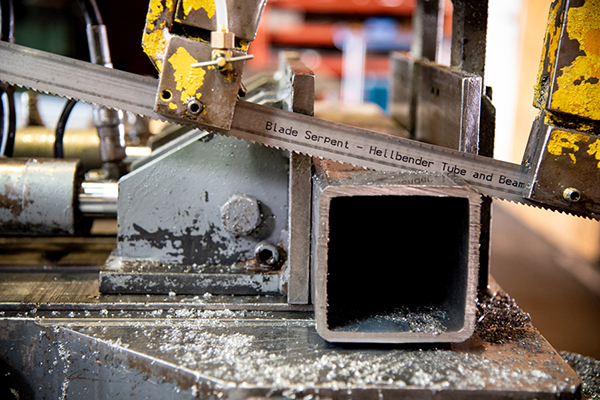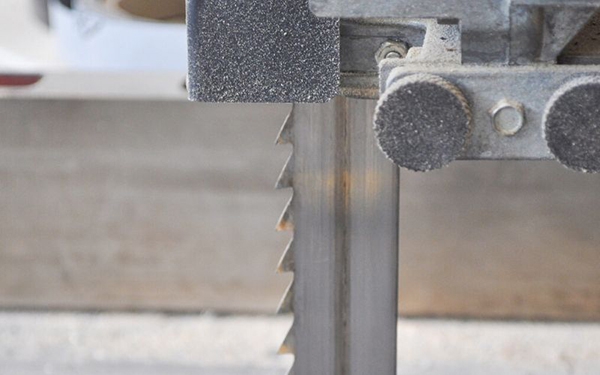Like you cannot have a chainsaw without a chain, you cannot have a band saw without a band. The band refers to the blade of a band saw. It’s a continuous looping band that is wrapped around a pulley. This blade spins on the pulleys. There are different types of bandsaw blade. A band saw is a real versatile tool and it can perform different types of cuts. To cut through different materials and to perform different types of cuts, it requires different types of blade. Not the same blade can be perfect for all types of cutting. Now what you have to do is to select the right band saw blade for the particular type of project.
We will be discussing here on the different band saw blade types. Some are good for curve cuts, some are good for cutting through hard woods, some are good for re-sawing. This depends on the material of the band saw blade, the size of the band saw blade, the density of the teeth and so on.
For precise cuts, you need thin blades, to cut through wood logs you need wide blades. To rip through soft metals, some has steel teeth, some have carbide-impregnated teeth to cut through stainless steel with them. So now you know there are various types of blade. You just have to choose the right band saw blade. How will you do that? Let’s move further.
We will discuss 6 different steps of choosing the right band saw blade.
The first step is to choose the materials
For woodworking, you should choose carbon tool steel blade. If you need to perform a wide range of re-sawing, you should be looking for the low-kerf blade. Low-kerf blades are thinner and they cut finer. For making piles and veneers, carbide impregnated re-saw blades are ideal choice. They can even cut through non-ferrous metals.
For a metal cutting band saw, you will need a bi-metal blade or carbon tool steel blade. The second option is cheaper than the bi-metal blade. Carbon tool steel blade can cut through mild steel pretty easily if the speed is less than 200 fpm (feet per minute).While cutting through metal, use coolant on the blade, otherwise, it causes wear too quickly. And if you want a longer lasting blade, go for a bi-metal blade.
M42 tool steel is welded via an electron beam to a strip of high strength steel, and then the teeth are punched into the carbide strip. Bi-metal blades can cut harder metals and lasts 10 times longer than a carbon tool steel blade. Bi-metal blades cover the widest range of sawing application and materials.
No matter which materials you purchase, make sure that you go through the details specification sheet on the packaging of your blade to know which materials they can cut properly and what you are going to cut with that. Make sure they are compatible with your applications.
The second step is to choose the blade width
Blade width is measured from the tip of the teeth to the back edge. Most of the vertical band saws allow different types of blade width, while most of the horizontal band saws are capable of supporting a fixed width of the blade. So you must check the manuals of your band saw to find the instruction for your machine to select the blade width. For most vertical band saw you should be able to use a wide range of blade width, from 1/8” to 1”.
You must know how the blade width impacts on the performance of the band saw. The smaller the width is, the tighter is can turn while cutting curves. I have attached a small chart that shows the blade widths along with their corresponding minimum circle radius. The minimum circle radius refers to the radius of the smallest circle that you can cut with that particular blade width.
Step three is choosing the pattern of teeth
There are three common types of teeth pattern available for band saw blade. The most common type is the regular pattern and this is most widely used. This is best for cutting thin materials where a fine cut is required. This pattern consists of proportionally spaced out teeth. Regular teeth pattern is great for both cut-off and contour sawing. The second pattern is the skip pattern.
It has widely spaced teeth with 0° rake angle to prevent clogging while cutting soft and non-ferrous metals, plastics, woods. If you need fast ripping, the third pattern will be great that is called hook-teeth pattern. As the name suggests, this pattern consists of larger teeth and a positive 10° angle, and deeper gullet. For cutting through hardwood or metals, hook-teeth are helpful.
There are different types of teeth set for a band saw blade. The raker teeth set consists of one to the right, one to the left and one is unset. This is used to cutting thicker, solid metal sections on horizontal cut-off machines. On vertical bandsaw, this set is used for contour cutting and re-sawing. The second set is called alternate set and used for faster and smoother cuts. The wavy set has a group of left set teeth and a group of right set teeth, separated by unset raker teeth. This is great for cutting thinner materials, like tubes, pipes, this shits etc.

Step four is choosing the right TPI (Teeth per Inch)
This is a very important consideration because this number of teeth per inch will help you to obtain the desired finish. More TPI means smoother finish but lower feed rate. Lower TPI will give faster feed rate but coarser finish. What you have to do is to choose the right TPI for achieving a perfect balance between the finish and the feed rate. The thickness of the material is also a variable here. A fine toothed blade of 18 to 32 TPI, should be used for thinner materials under ¼”. For general cutting of ¾” wood, 4 TPI will offer fast cut and 14 TPI will be slow but give you a smoother finish.
Step five is choosing the thickness of the blade
You know that the blade in a band saw actually works like a band. It has to be extremely flexible. The continuous flexing and heating and cooling cause metal fatigue, therefore the failure. That’s why it’s important to choose the right thickness of the blade. The blade thickness is the distance between the two flat sides of the blade, its lateral width. The thickness of the blade should be chosen according to the diameter of the wheel and the cutting applications. Thick blades can tolerate more cutting strain from straight cuts. But they break more easily from bending and twisting cuts. The thinner blades are recommended for lighter applications. Here goes a guideline for you.
For wheels of 4” and 6” diameter, the recommended blade thickness is 0.014”. For 6 to 8” wheels, get a blade of 0.018” thickness. There are wheels of different diameters, please follow the image above for a clear sense of what thickness you should choose.
The sixth and the final step is choosing the right size of the blade
This refers to the length of the blade. This should be mentioned in the user manual. Or you can simply calculate the appropriate length of your band saw.
For a two wheeled pulley, align the pulleys in working position. Set some tension on the top wheel. Find the distance between the central hub of the lower and the upper wheel. This reading is “C”. Measure the radius of upper and lower wheel, they are “R1” and “R2” respectively. Now the length of the blade will be “L”, where L= (R1×3.1416) + (R2×3.1416) + (2×C)
For a three wheeled pulley, align the wheels in working position. Set some tension on the top wheel. Determine the center to center distance between the two drive wheels that is “C”. Determine the radius of the upper and lower drive wheels, they are “R1” and “R2” respectively. So the blade length L= (R1×3.1416) + (R2×3.1416) + (2×C)
Related post: How To Choose The Best Miter Saw?




